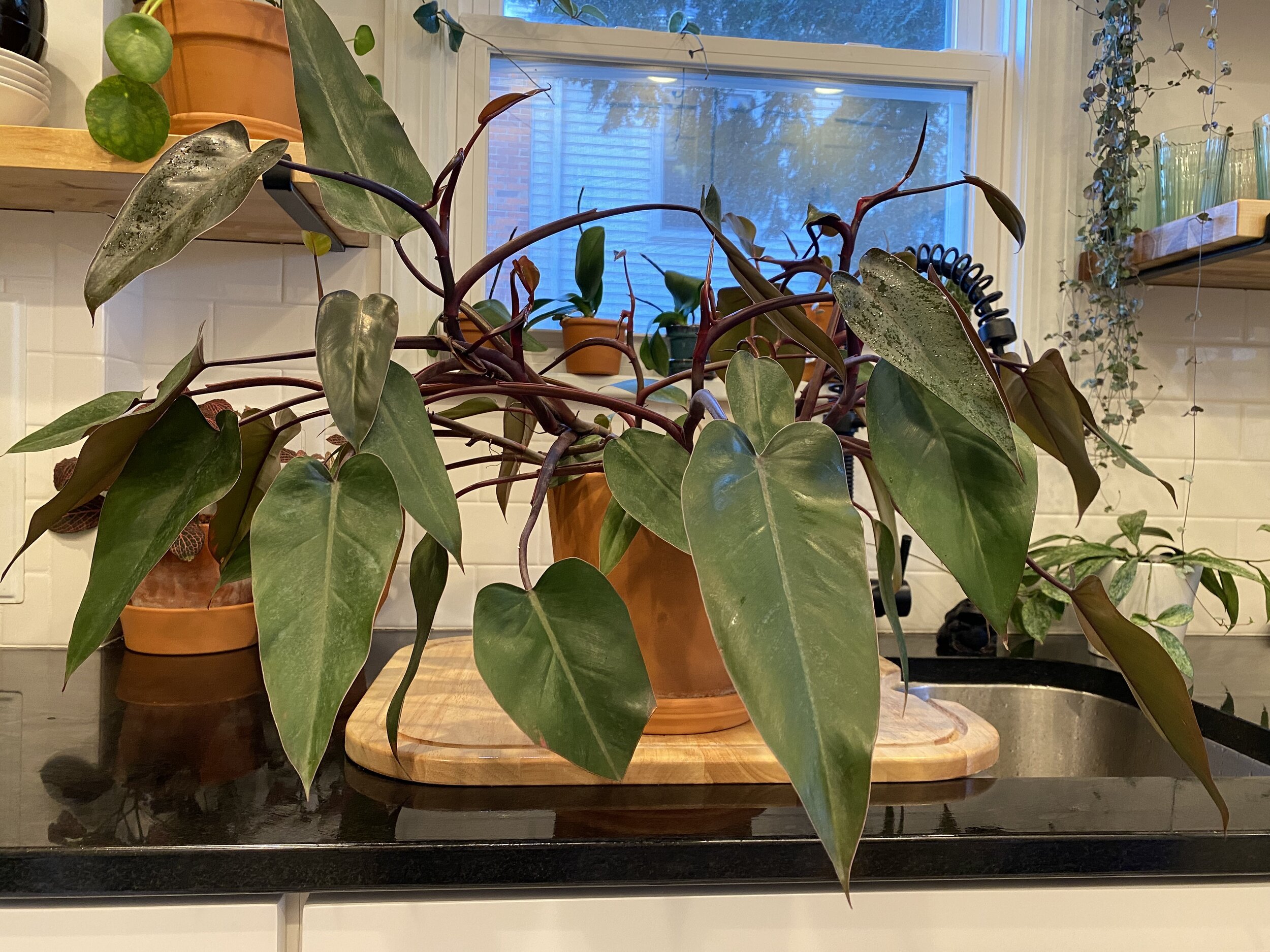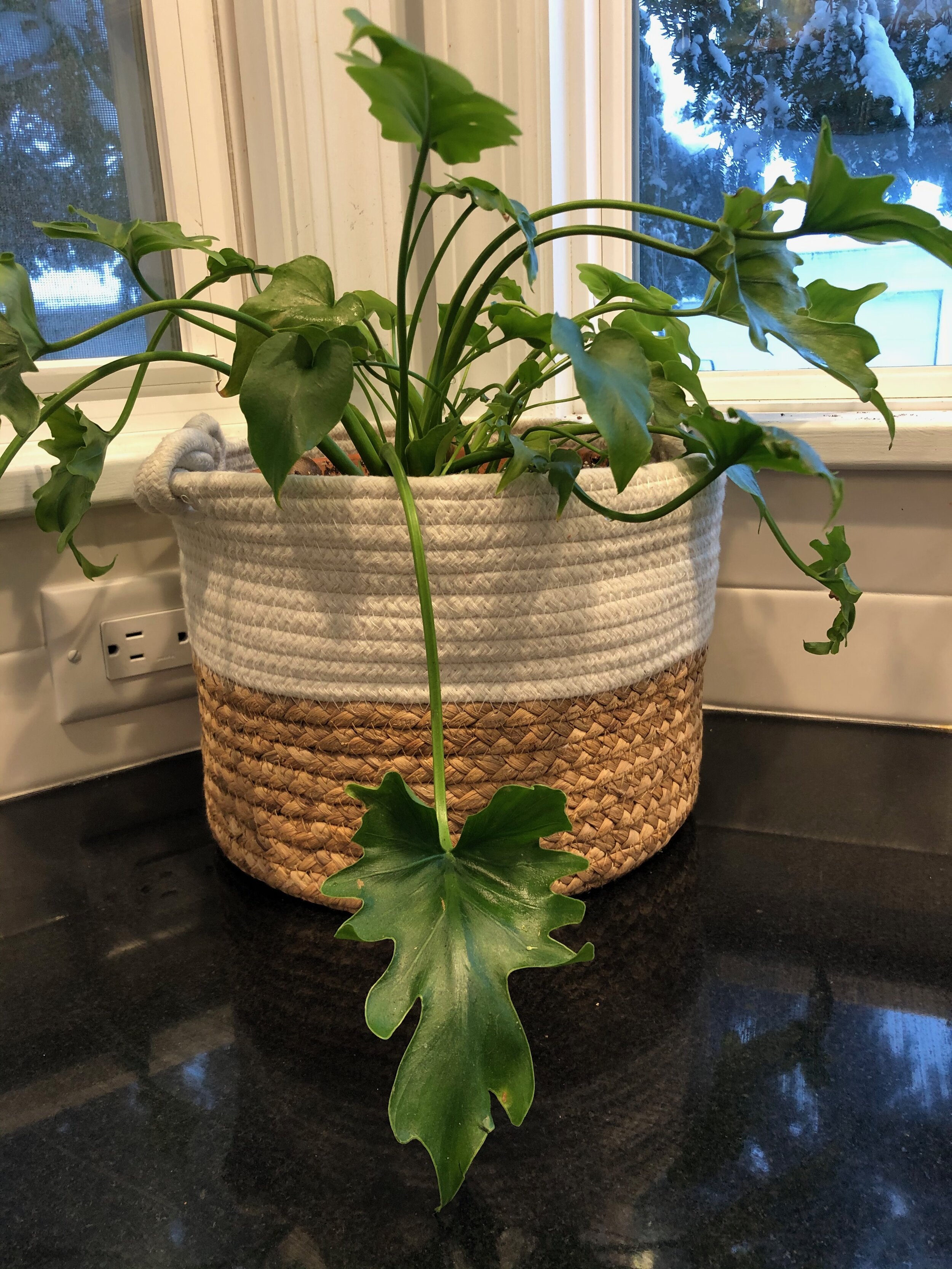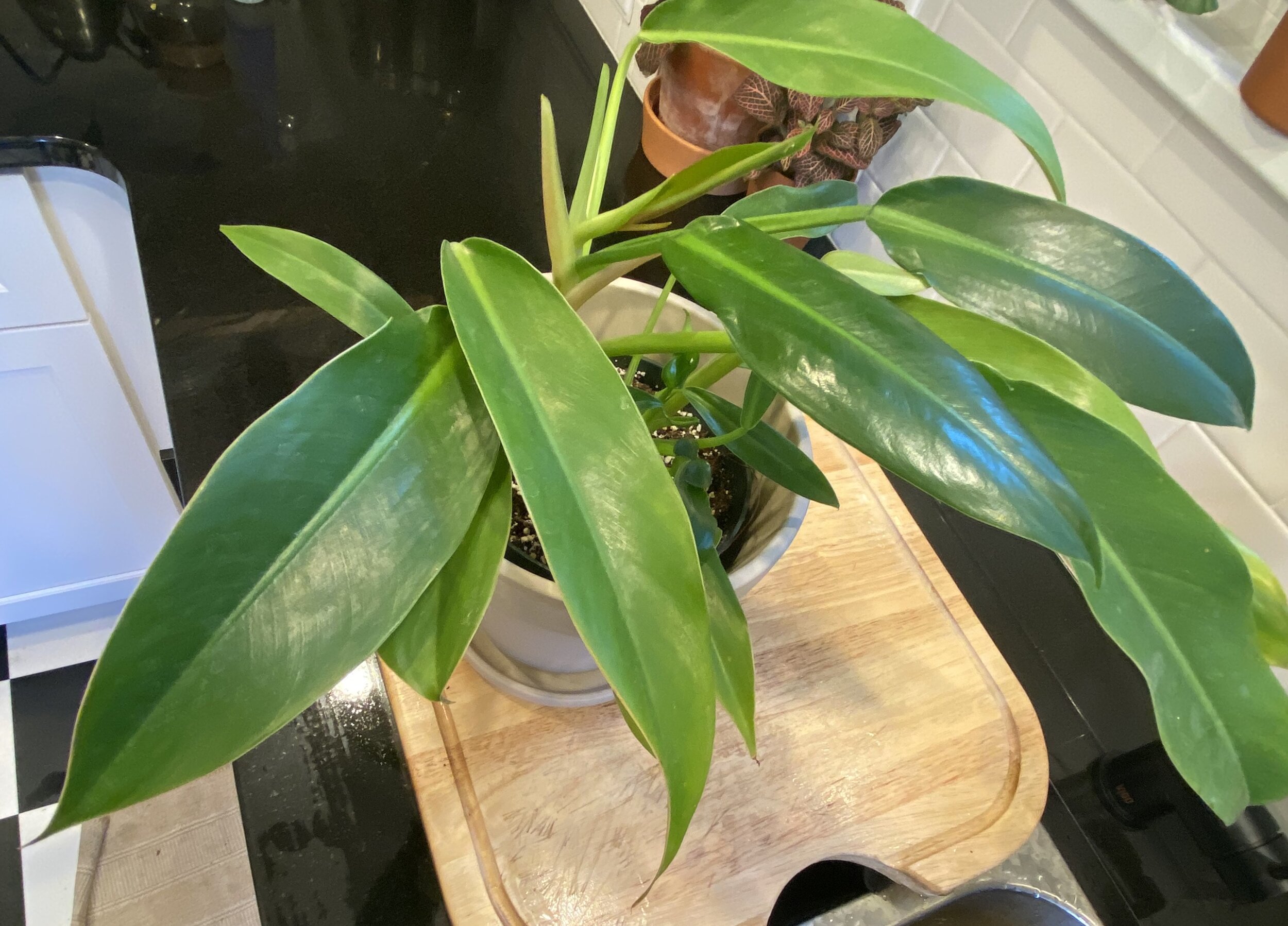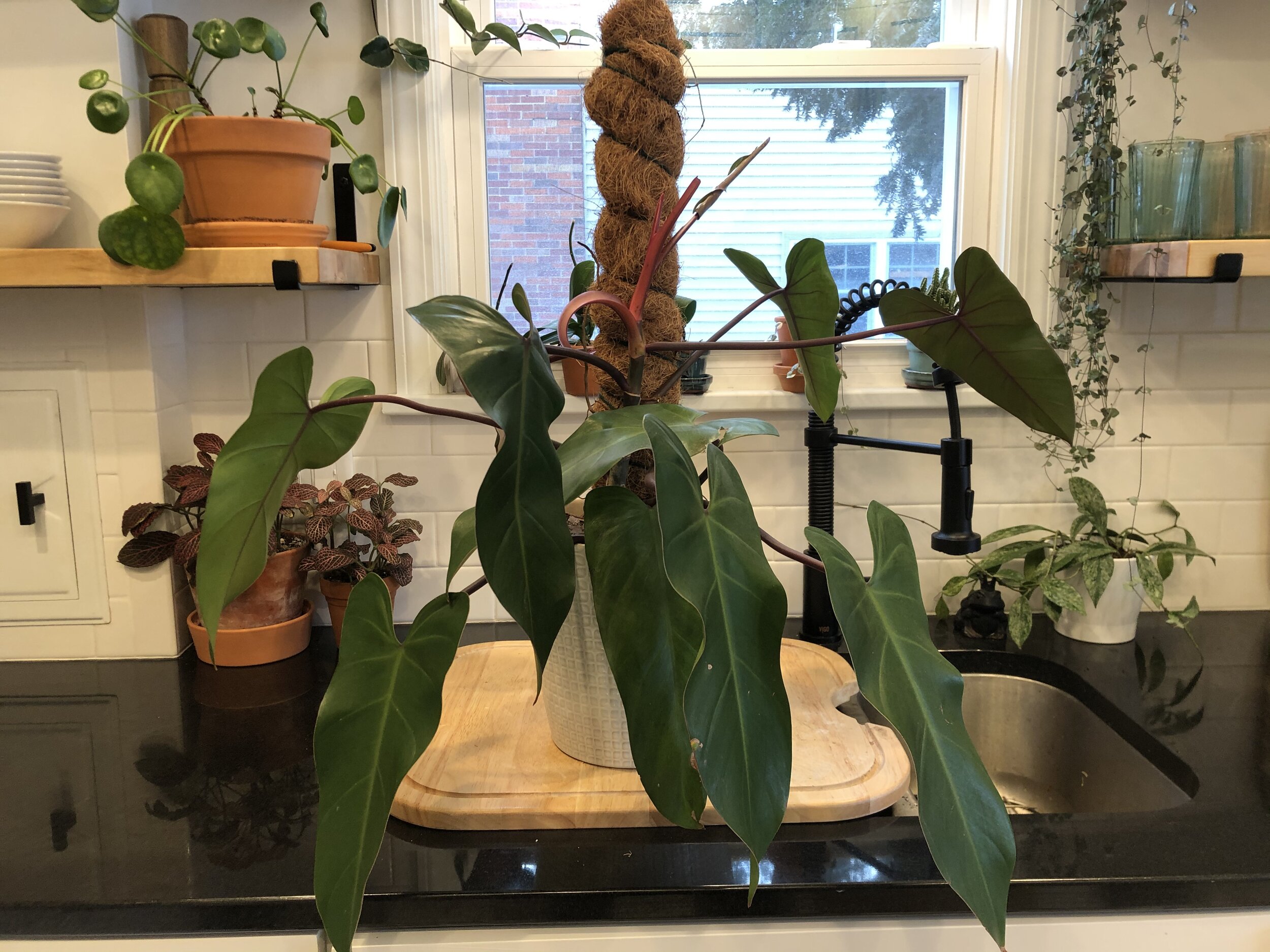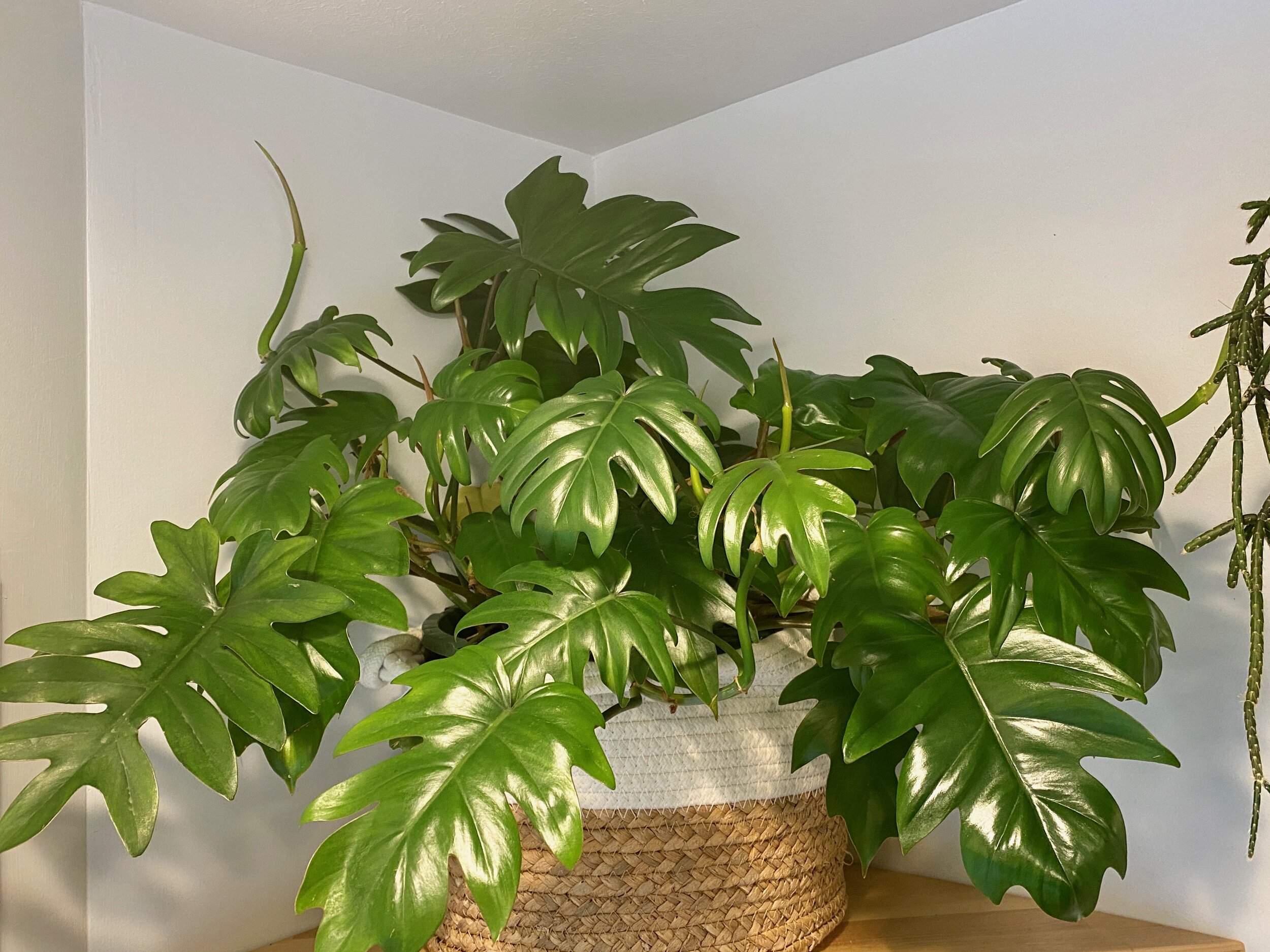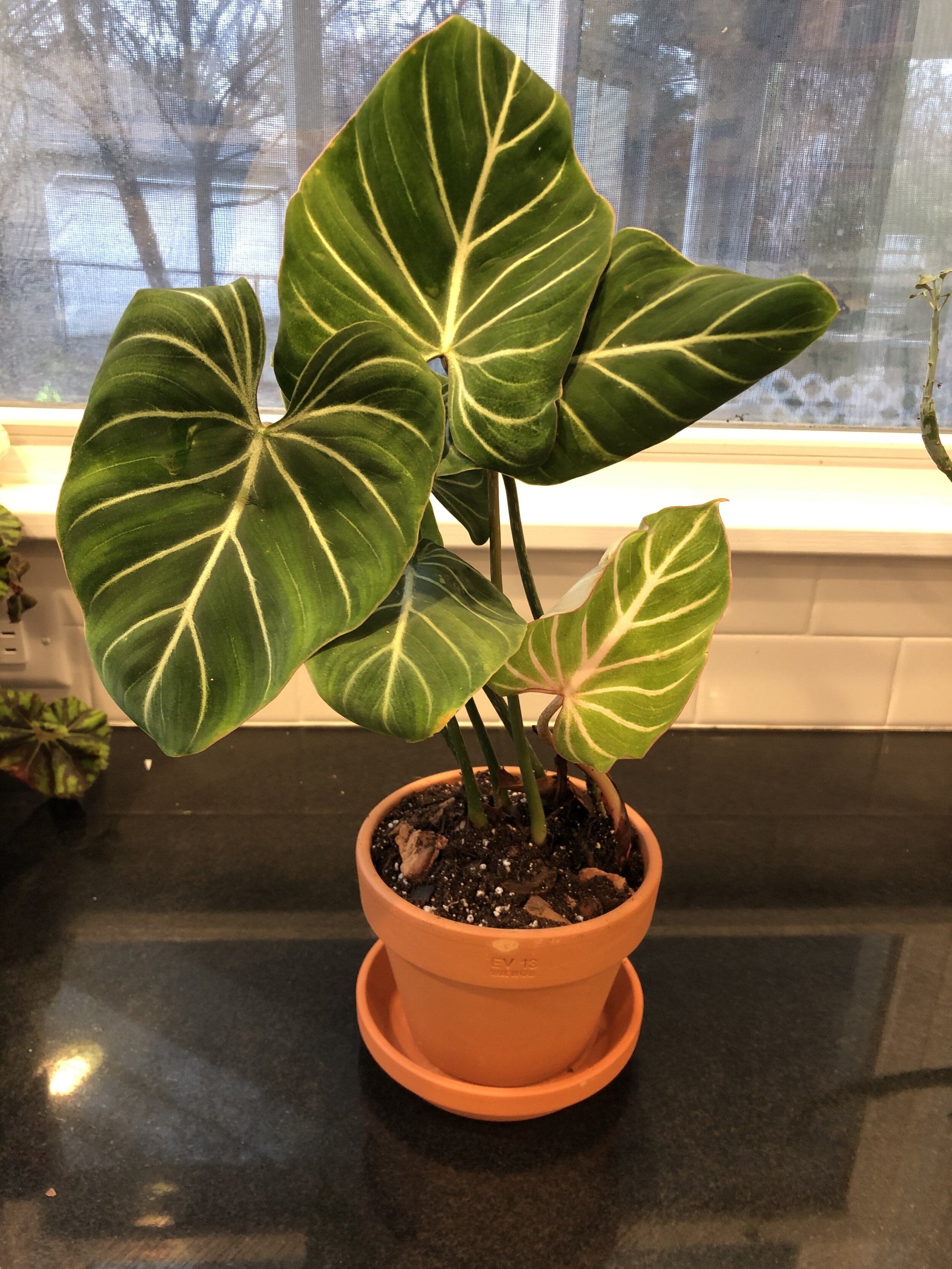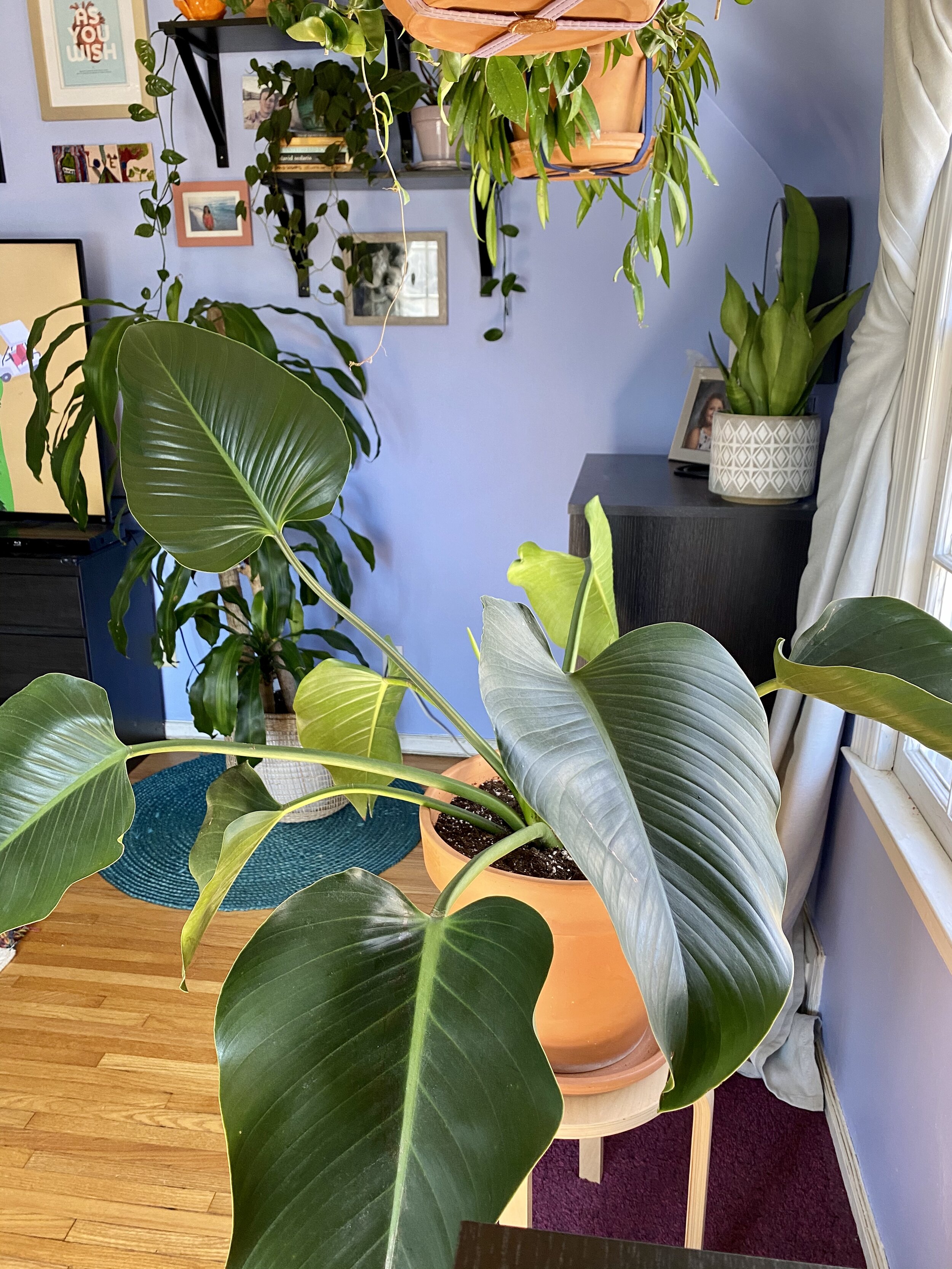
Philodendrons.
Philodendrons are a part of the Aroid family, one of the largest groups within the family, in fact. Most Philodendrons originate in the Rainforests of Central and Southern America, where they enjoy the warm and humid climate. Philodendrons have been seen as beautiful and laid-back additions to the household environment for ages. Though they come from the Rainforest, these plants are adaptable when it comes to light, and even with temperature and humidity. They help to clean our indoor air, and they can add a pop of positive energy to nearly any indoor space. Though there are hundreds of members of the Philodendron genus, plants have been crossed and hybridized countless times, often with the resulting plants being even more adaptable than their parents.
There are two types of Philodendrons: Vining and non-vining.
Vining Philodendrons include the classic Heartleaf Philodendron, P. Red Emerald, P. Brandtianum, as well as dozens of others. Vining philodendrons also include the beautiful P. Gloriousum, P. Pastazanum, P. Mamei, and others who creep along the top of the ground via the stolon.
Non-vining Philodendrons, also called self-heading, are also desirable houseplants as they often grow into many-layered mounds of colorful leaves. P. “Moonlight,” P. “McColley’s Finale,” and P. “Rojo Congo” are all self-heading Philodendrons.
Philo = Love
Dendron = Tree
Philodendron
Hederaceum
“Heartleaf Philodendron”
I have two of these delightful plants, and I wish I had room for a thousand more. This was my first true plant love many years ago, and it remains one of my favorite plants to this day. This plant sits directly in an Eastern facing window, and it grows steadily. I check it every 7-10 days to see if it needs water, and I water accordingly. It’s generally quite an easygoing and flexible plant, and beautiful, too! It can climb or trail. It would likely be climbing in its native Carribean and Central American habitat. It’s known as one of the most common houseplants, and for good reason. It’s gorgeous and its needs are easy to meet with a little bit of time and care. It can handle low to moderate light, and isn’t fussy about humidity. If you pamper it with proper fertilizing and the occasional misting, it will keep gracing you with its gorgeous, laid-back self.
Philodendron Hederaceum “Lemon Lime Heartleaf Philodendron”
Care for this plant is not unlike the green heartleaf Philodendron.This Philodendron lives happily in a corner between Eastern and Northern facing windows. It’s a fairly speedy grower, with new growth often emerging in beautiful pinkish-orange shades, then yellowish, and finally into a lime green. This, obviously, is where it gets the name “Lemon Lime.” It can do with lower light, but it will be content and productive with nice and steady lighting. This is why I find that it appreciates the consistency of a Northern facing window. As for water, I watch this one carefully as I have it in a pot without drainage. I water it every 7-10 days, depending on the season.
Philodendron “Bloody Mary”
I purchased this plant as “Philodendron Bloody Mary Cultivar, “ although I have seen it sold under other names. It has elongated, heart-shaped leaves and blood-red petioles. Leaves emerge deep red and mature to green. It is a vining plant, although mine has not been trained onto a coir pole yet. It can have a lovely draping habit, and I’m enjoying it presently until I get to making a new pole. I keep this plant in lower light than I had planned, but it seems so content that I hesitate to move it. It currently sits about 8 feet back from an eastern window and 4-5 feet from a Northern facing French door. I test with a moisture meter before watering this plant. I look for the meter to be in the 1-3 or “dry” range before watering. I have found that the leaf points will turn a splotchy yellowish shade when kept too moist. Though I use a terra-cotta pot and nice Aroid soil, I believe that the lower light conditions reduce this plant’s need for frequent watering. I was certain when potting this plant that the terra-cotta was exactly the same size as the nursery pot to prevent soggy conditions after a thorough watering. It has never been picky about humidity, either. This is a plant that has been very comfortable in regular household conditions.
Philodendron “Burle Marx”
This Brazilian plant got its name from, of course, Burle Marx who had a prolific career as a landscape architect. He played a major role in bringing aroids into cultivation. It’s known to spread across an area quickly in the wild, covering large areas of ground. As you can see from the photo, roots reach out from the plant, grabbing at the ground or any other available surroundings and anchor the plant so it can continue moving as it pleases. This plant lives approximately 2 feet away from a Western facing window on the second floor of my home. It gets consistent light through the window, and about 3 feet above is a single grow light. This plant seems to love these conditions. It isn’t sassy about water needs, either. I have never found this plant to pout or wilt when it needs water. I tend to water this plant whenever I water the other Aroids in the same area, just for good measure. I know it can go longer, but it also doesn’t mind the water when it can get it. I do believe, however, that less established plants prefer more frequent watering than a more established plant. It is quite resilient, I’ve found, with one exception. It does not appreciate being exposed to cold temperatures.
Philodendron “Rojo Congo”
This plant was a bit of a project, and we’re not quite out of the woods yet. I found it for under $10 on the “dead rack” at a big box store, flopped over on one side with a couple of battered leaves. I saw a spark of hope in it, though, and thus far it’s proving that it has the will to live. It has put out about six healthy leaves in the year I’ve had it, and it has another on the way. This is another plant that surprised me with it’s preference for lower light. I originally placed it in a nice sunny, Eastern window and waited for it to take off. It didn’t feel right, however, in that spot and I decided to put it next to a dim lamp in the dining room until I figured out a better spot for it. To my surprise, it quickly began popping out new leaves and has been ever since. It sits very close to Northern facing French doors, and it has it’s trusty lamp nearby. I wouldn’t normally seek out these precise conditions for this plant, but this seems to be the space this plant chose! As for water, I check this plant once a week for dryness and typically end up giving it a small drink. I never soak this plant or either of my other Congos through the drainage hole. I have found that smaller amounts of water on a more frequent basis are the way to go with this plant in my particular conditions. Hybrid Philodendron “Rojo Congo” is a self-heading plant, so it won’t form vines climb, and it does tend to be larger than some smaller hybrids like “Moonlight,” or “McColley’s Finale.”
Philodendron Domesticum “Lemon Lime Upright”
Lemon Lime Upright is a beautiful, climbing Philodendron with long, oval-shaped leaves. I keep this plant in a cluster of other Aroids near a Western facing window. It also gets minimal light from a grow lamp that I have mounted on the wall above. Some like to let this plant hang, but I have found that the vines aren’t as pliable as the Heartleaf variety of Philodendron and therefore the plant seems more comfortable climbing-at least in my environment. Mine tends to grow bushy first, then send up a vine. I am very careful not to overwater this plant. I think under normal circumstances, this plant would appreciate watering on a basis that’s similar to the other Philodendrons, but I have two plants and a Coir pole in this pot, and I don’t like to risk overwatering with everything going on in there.
Philodendron Bipinnatifidum “Little Hope”
This cute little plant doesn’t get much bigger than a 6-8 inch pot can accommodate. I have found that this plant likes to live in close quarters, so keep it potbound if you can. It’s a great choice when you need a plant that’s unlikely to outgrow it’s spot quickly. I grow this plant in a North facing bay window in my kitchen. It gets consistent light, and even some heat and humidity from the nearby cooktop. It took a while to find a good watering cadence with this plant, but now that it’s more established, I’ve found that it’s more accepting of water when it comes rather than its previous finicky way. As with most of my plants, I check this plant weekly for water, but I find that it does best when I hold out a bit longer between waterings. I look for a 1-3 on the moisture meter for this plant to be happy in my environment. This plant isn’t patented, it really is a little Hope, as in Philodendron Hope. It’s a naturally occurring mutation that causes this plant to remain smaller. To further confuse matters, Philodendron Bipinnatifidum (AKA “hope” AKA “Selloum” AKA “Tree Philodendron”) was recently reclassified in 2018 as a Thaumatophyllum along with other former members of the Meconostigma subclassification of Philodendron. I know there has been much debate about the reclassification, and I’m not entirely sure where the debate stands at this time.
Philodendron “Little Phil”
This was my original “low light” Philodendron, and by that I mean that it was the first Philodendron that I intentionally put in lower light. When I purchased this plant, it came with a sticker that said, “Low light, let dry fully between watering.” I’ve followed those directions and this plant has been happy and thriving. It lives in conditions very similar to my “Rojo Congo,” near a Northern facing French door, and it lives near a lamp with a low output LED bulb. It is not a grow light. This plant is content and continues to put out more lovely, long pointed leaves. “Little Phil” is a trademarked name given to this dwarf Philodendron. It’s a tough plant, in my experience.
Philodendron Hederaceum “Micans”
This was a true wishlist plant for me. The leaves are velvety with a gorgeous iridescent look. Depending on the angle, it can look pinkish, greenish, orangish, and even some blueish shades. For as high maintenance as this plant looks, it’s remarkably laid back for me. It takes light and water when it can get it, and keeps on growing as if it’s loving life. I have two of these plants, the one shown here, and a smaller but slightly longer plant that I keep in brighter light. I do notice that the plant getting more light grows more quickly…no surprise there, but both plants have similar habits. Both of my plants trail out of their pots, but like any Philodendron Hederaceum, they can and will climb and you’re likely to get larger leaves from your plant if it’s climbing. They receive water when the soil is dry, which is closer to weekly for the smaller plant and closer to every 10-12 days for the plant here. Neither pot has a drainage hole, so I try to be contentious of overwatering either of these plants.
Philodendron “Moonlight”
This self-heading (non-vining) Philodendron McColley hybrid is eye-catching. I’ve found it to be accepting of most low to medium light conditions in my home. I keep this plant in the dining room, several feet back from a sunny Eastern facing window and a couple of feet away from North facing French doors. This is another plant that I do not like to over pot. It can become very full, with neon green leaves that sprout out from the middle of the plant and reach a darker shades green as they harden off with age. I monitor the soil weekly on this plant and usually end up watering it every 7-10, depending on the season.
Philodendron Erubescens “Red Emerald”
This was another wish list plant for me, and another plant that has been really versatile and laid-back. “Red Emerald” is not a trade name, and I’ve often seen this plant referred to as “Blushing Philodendron.” I don’t worry so much about the name as I do about the proper care. It climbs, and FAST. This plant puts out a new leaf, and a few days later I’m seeing a new leaf begin to emerge. In it’s native Columbia, it can climb 15 + feet up the side of a tree. This plant lives in an East facing window, however, it rarely gets any direct sun despite its close proximity to the window. It gets very consistent, bright indirect light all day long. There are no curtains to dim the light. This plant has only ever lived in this East window, unlike many of my other plants who bounce around a few times before they settle into a final home. I really believe that Philodendrons love East windows in my zone and a few other zones that I’ve observed. This plant is no exception. I water on an occasional basis because this pot does not have drainage and it houses two plants and one coir pole. I try to be careful not to overwater in those circumstances.
Philodendron Verrucosum
This climbing Philodendron of Ecuadorian origin has thin, velvety leaves with a striking pattern. I was a little afraid of it at first because it looks very fussy. I haven’t found that to be the case, at least not yet. I keep this plant in an Eastern facing window where it receives bright light but no direct sunlight. It lives under a large Monstera Deliciosa that blocks out any direct light coming through the windows. I keep this plant in close proximity to a humidifier because it is known to appreciate (if not require) more humidity than most household Philodendrons. So far, this system seems to be working well for the plant. It is putting out new leaves, and I’ve noticed that the hairy stems look a bit more perky with the humidifier. I check this plant twice weekly and water when the plant is dry. Due to the smaller size of the terra-cotta pot, plus the chunkier Aroid soil does dry out faster than say, a plastic pot filled with a heavier soil. I prefer the terra-cotta and fast draining soil for this plant, though, because it was a difficult to find plant and I like the extra control I have when it comes to overwatering. I have read that there are several varieties of this plant on the market with different areas of origin and differing home altitudes. Some do not have the “hairy” stems and some do not have the deep red patterns on the leaves. I chose this Ecuadorian variety because I felt I had the best chance of meeting it’s needs.
Philodendron “Tahiti”
This has been such a rewarding plant. I came upon it by accident, which is to say I didn't really have it on any “wish lists” when I found it. But I’m so glad I did find it. The leaves are so interesting and it really doesn’t ask for much. “Tahiti” is of unknown origin, at least to me. It’s a vining plant that will eventually require a moss pole to climb. Currently, it grows in my North facing bay window where the light isn’t strong, but it’s constant. It’s still in the nursery pot, from which I removed the plastic hanger so I could put it inside a basket. When I water this plant, I water it until the water comes through the drainage hole and I soak the foliage as well. It appreciates a more thorough watering with less frequency in my conditions. This plant was propagated with many stems inside the pot, so it is very full inside. I expect the care needs will change if I decide to change the pot or potting medium. Due to its location near the ceiling, it does seem to appreciate the occasional light coming from the LED bulbs in the ceiling.
Philodendron Gloriosum
In it’s natural Columbian habitat, velvety Philodendron Gloriousum creeps vertically along the ground, eventually creating a hedge-like shape. The vine, known as a stolon, needs to be on top of the soil to most naturally recreate the way this plant would grow in the wild. The roots will drop down into the soil from the stolon, though you might need to stake the plant for stability. Burying the stolon or the growth point could easily result in rot. I know that eventually this plant will need either a longer, more shallow pot, or to be trimmed regularly as it grows. For the time being, this plant is living along with many other Aroids in my Western window where it receives medium light, plus a supplementary grow light mounted on the wall above it. The light doesn’t offer enough light that it could stand alone, but I do like that it’s supportive of the naturally occurring light. This is a plant that does not appreciate overwatering. The emphatic advice I was given by the grower was do not overwater. I’m keeping in mind that she is an outdoor grower and my conditions are quite different. I am currently watering weekly, as that is what my particular conditions require, but I do expect to water this plant more in the summer and less in the winter. In my experience, indoors this plant is a slow and quite sensitive grower. The sensitivity is particularly in relation to temperature and humidity. It enjoys temperatures over 60 degrees Fahrenheit and humidity as high as you can get it within the home. I keep this plant within close proximity to a humidifier.
Philodendron “Black Cardinal”
This self-heading Philodendron was originally a plant I sought out because I had hoped, in vain, that it would actually have black leaves. Thus far, I’ve seen a deep purplish green as well as emerald green on the older leaves and reddish color on the newer leaves. I still find it beautiful, of course! I keep this plant about two feet from a west window. It has grown rapidly in this spot and I wont’t move it until it outgrows the current location. As for watering, I check for dryness on a regular basis as I do with a lot of my 4” or smaller pots and I water it weekly. “Black Cardinal” is a McColley hybrid, hybridized in Florida.
Philodendron Brandtianum
Philodendron Brandtianum is a versatile plant. In it’s natural South American environment, it can grow…nearly anywhere. This plant can grow as an epiphyte, rooting itself high in a tree and clinging as it climbs up into the canopy, or it can originate as a terrestrial and creep along until it finds something to climb in search of more light. Either way, vines are the common denominator. This plant does appreciate humidity, but I haven’t found it to be excessively demanding about it. I keep it clustered with many other plants in my West facing plant nursery cart where it has access to humidity every day. It isn’t demanding about water, but it’ll let you know if you’ve gone too long between waterings by curling its leaves. I don’t let it get to this point, as I’d rather not stress the plant unnecessarily. I check it weekly and usually end up finding that it’s in need of water in that timeframe. It hasn’t been an especially fast grower for me, but I’m hoping that’ll change. The leaves can reach 6-7 inches long, but are unlikely to do so indoors, especially if it isn’t climbing.
Philodendron Hederaceum “Brasil”
I treat this Brasil much the same as my green and lemon lime heart-leaf Philodendrons. It isn’t needy, and it thrives in many different spots in my home (I have four). The foliage is so striking, it never fails to impress. Depending on the size and potting environment of each plant, I go from 5-10 days between waterings. The plant will give a little droop to let me know it’s time for water if I’ve missed in my regular rounds. This plant lives from very low light to medium light within my home. The smallest plant, about 3 years old, lives in very low light in the bathroom, whereas another hangs directly in an East window. A third lives in a deep corner without much natural light. And the final plant lives on a top shelf in the kitchen where it receives a combination of natural and LED lighting. All four show steady growth with care and attention to the differences their specific homes might require. This is a great plant for those just learning plant care, and also a great choice for experienced growers.
Philodendron “McColley’s Finale”
This self-heading philodendron was hybridized by, no surprise, McColley who is also credited with popular hybrids like P. “Moonlight” and P. “Prince of Orange.” They can be rapid growers and develop a wide and dense display of various colored leaves. The newest leaves emerge bright red and deepen into an emerald green as they age. I’ve had my share of trouble with this plant and it’s close relation, “Prince of Orange.” I have learned that many Philodendrons are very versatile when it comes to potting and soil, but this one likes to remain tight in it’s pot with a soil that dries evenly. A problem I was having initially, which I believe we’ve now sorted out, was that the soil was remaining damp in the lower 1/3 of the pot, and thus the plant wasn’t drying evenly. In a rare turn, I downsized this pot and added more chunky fir bark to the mix so that oxygen could reach the roots more freely. This seemed to alieviate any issues, and the plant began to put out new leaves again. This plant lives in the basement underground surrounded by grow lights. It gets a weekly check for watering, and the needs remain fairly consistent.
Philodendron “Green Congo”
This plant is treated much the same as “Rojo Congo, “ except I purchased it at a much larger size than the “Rojos.” This plant is a self-heading variety, and it has quite a spread. The whole plant is nearly four feet wide, maybe more. I have seen them for sale in the nurseries with the leaves all pointing upward and the stems close together as if they’re almost touching. In my experience, they do spread out a bit more once they get comfortable. This plant lives with East and South facing windows. It can’t get enough indirect light. It’s always wanting more, and it puts out more of its especially thick, rigid leaves frequently. A very surprising contrast to the “Rojo Congo,” which doesn’t mind low light but still puts out many leaves. I don’t often soak the soil when I water this plant. It requires a larger pot to balance it’s size, and I’m careful not to drown the roots by allowing all that soil to sit soaking for too long. I use smaller waterings, but more frequently for this plant.
Philodendron Pastazanum
Like Philodendron Gloriosum, P. Pastazanum also creeps horizontally along the surface of the soil via stolon as it grows. It does not like to have the stolon or growing tip buried under the soil. It likes a lot of light and prefers humidity as well. I was a little afraid of this plant, but I’ve found it to be very agreeable and would highly recommend it. It lives in a West window with supplementary grow lights and a humidifier. That sounds fussy, but it’s really one of those plants that doesn’t give me a bit of trouble. It’s striking and easygoing. A great combination. This spring I gave it a top dressing of worm castings and I water it with a water soluble fertilizer every other watering. This plant is a species plant from Columbia, but can occasionally be mistaken or incorrectly sold as Philodendron McDowell (P. Pastazanum X P. Gloriousum) due to their resemblance.



